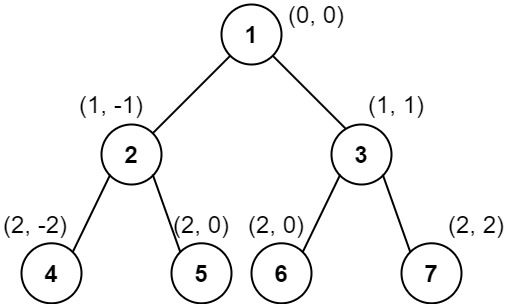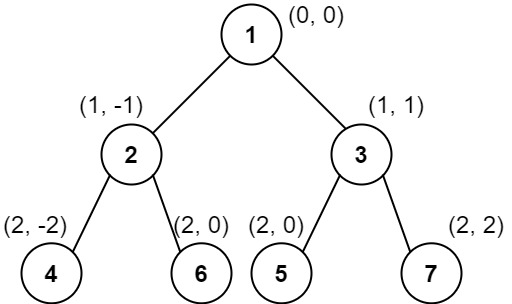987.二叉树的垂序遍历
【LetMeFly】987.二叉树的垂序遍历:遍历时存节点信息,遍历完自定义排序
力扣题目链接:https://leetcode.cn/problems/vertical-order-traversal-of-a-binary-tree/
给你二叉树的根结点 root ,请你设计算法计算二叉树的 垂序遍历 序列。
对位于 (row, col) 的每个结点而言,其左右子结点分别位于 (row + 1, col - 1) 和 (row + 1, col + 1) 。树的根结点位于 (0, 0) 。
二叉树的 垂序遍历 从最左边的列开始直到最右边的列结束,按列索引每一列上的所有结点,形成一个按出现位置从上到下排序的有序列表。如果同行同列上有多个结点,则按结点的值从小到大进行排序。
返回二叉树的 垂序遍历 序列。
示例 1:

输入:root = [3,9,20,null,null,15,7] 输出:[[9],[3,15],[20],[7]] 解释: 列 -1 :只有结点 9 在此列中。 列 0 :只有结点 3 和 15 在此列中,按从上到下顺序。 列 1 :只有结点 20 在此列中。 列 2 :只有结点 7 在此列中。
示例 2:

输入:root = [1,2,3,4,5,6,7]
输出:[[4],[2],[1,5,6],[3],[7]]
解释:
列 -2 :只有结点 4 在此列中。
列 -1 :只有结点 2 在此列中。
列 0 :结点 1 、5 和 6 都在此列中。
1 在上面,所以它出现在前面。
5 和 6 位置都是 (2, 0) ,所以按值从小到大排序,5 在 6 的前面。
列 1 :只有结点 3 在此列中。
列 2 :只有结点 7 在此列中。
示例 3:

输入:root = [1,2,3,4,6,5,7] 输出:[[4],[2],[1,5,6],[3],[7]] 解释: 这个示例实际上与示例 2 完全相同,只是结点 5 和 6 在树中的位置发生了交换。 因为 5 和 6 的位置仍然相同,所以答案保持不变,仍然按值从小到大排序。
提示:
- 树中结点数目总数在范围
[1, 1000]内 0 <= Node.val <= 1000
方法一:遍历时存节点信息,遍历完自定义排序(以广度优先搜索为例)
广度优先搜索(BFS)相信大家都不陌生,因此我们可以二话不说将二叉树广搜一遍,在搜索过程中将所需要的信息计算并存下来,剩下的就是按照题目规则自定义排序了。
都需要哪些信息呢?需要“节点在哪一列”、“节点深度”、“节点值”。
遍历过程中将上述三元组存下来,遍历完成后依据这三个信息排序,作为答案并返回即可。
- 时间复杂度$O(N\log N)$,其中$N$是二叉树中节点的个数
- 空间复杂度$O(N)$
AC代码
C++
1 | |
Python
1 | |
同步发文于CSDN,原创不易,转载经作者同意后请附上原文链接哦~
Tisfy:https://letmefly.blog.csdn.net/article/details/136106019
987.二叉树的垂序遍历
https://blog.letmefly.xyz/2024/02/13/LeetCode 0987.二叉树的垂序遍历/